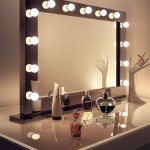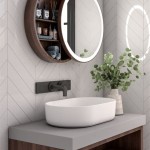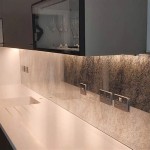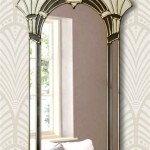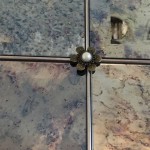Can You Hang A Mirror With Double Sided Tape On The Walls? An Exhaustive Guide
Hanging a mirror presents a common decorating dilemma. Traditional methods, such as using nails or screws, involve drilling holes that can damage walls and require patching upon removal. Double-sided tape emerges as an alternative, promising a damage-free and relatively simple installation. However, the suitability of this method depends on several factors, including the mirror's weight, the wall's surface, and the type of tape used. This article provides an in-depth examination of the viability of hanging mirrors with double-sided tape, analyzing the associated risks, benefits, and crucial considerations.
The core question revolves around the adhesive strength of double-sided tape and its ability to withstand the gravitational forces acting on the mirror. While some double-sided tapes are explicitly marketed as heavy-duty and capable of supporting significant weight, the actual performance can vary substantially depending on the specific product and the application conditions. Understanding these nuances is critical to avoid potential hazards, such as the mirror falling and causing damage or injury.
Furthermore, the longevity of the adhesive bond is a significant concern. Even if the tape initially holds the mirror securely, factors like temperature fluctuations, humidity, and the natural degradation of the adhesive over time can weaken the bond. This can lead to the mirror gradually detaching from the wall, increasing the risk of an unexpected fall. Therefore, careful consideration must be given to the long-term reliability of double-sided tape as a mirror-hanging solution.
Weight Considerations and Tape Selection
The weight of the mirror is arguably the most critical factor in determining the feasibility of using double-sided tape. Lighter mirrors, typically those under a few pounds, have a higher probability of being successfully mounted with appropriate tape. However, larger and heavier mirrors demand a tape with significantly higher weight capacity. It's imperative to consult the manufacturer's specifications for the double-sided tape to ascertain its maximum weight limit. Exceeding this limit drastically increases the risk of failure.
Selecting the appropriate type of double-sided tape is equally important. Not all double-sided tapes are created equal. Standard office tape is unsuitable for hanging even the lightest mirrors. Instead, focus on tapes specifically designed for heavy-duty applications, often labeled as "mounting tape" or "construction tape." These tapes typically feature a thicker adhesive layer and a stronger backing material, providing greater holding power. Look for tapes that explicitly state their weight-bearing capacity; for example, "holds up to X pounds per Y square inches."
Examples of suitable double-sided tapes include those made with acrylic foam or polyurethane foam cores, which provide excellent adhesion and shear strength. These tapes are often reinforced with a mesh or scrim to further enhance their durability. Some brands offer tapes specifically designed for mirror mounting, which may include additional features like moisture resistance. Always prioritize quality and choose a reputable brand known for producing reliable adhesive products.
Furthermore, consider the amount of tape required. The manufacturer's specifications will typically indicate the amount of tape needed per unit of weight. It's generally advisable to err on the side of caution and use slightly more tape than recommended, especially for heavier mirrors or in environments with fluctuating temperatures or humidity levels. Distribute the tape evenly across the back of the mirror to ensure uniform weight distribution and prevent stress concentrations.
Surface Preparation: The Foundation of a Secure Bond
Proper surface preparation is paramount for achieving a strong and lasting bond between the double-sided tape and both the mirror and the wall. Regardless of the tape's quality or weight capacity, a dirty, uneven, or improperly prepared surface will significantly compromise its adhesive performance. Failure to adequately prepare the surfaces is a common cause of mirror failures when using double-sided tape.
The first step is to clean both the back of the mirror and the wall surface thoroughly. Use a clean, lint-free cloth and a degreasing cleaner to remove any dirt, dust, grease, or other contaminants. Isopropyl alcohol is an excellent choice for this purpose, as it effectively removes residue and evaporates quickly. Avoid using cleaners that contain oils or waxes, as these can leave a slippery film that inhibits adhesion. Ensure both surfaces are completely dry before applying the tape.
The type of wall surface also plays a critical role. Smooth, non-porous surfaces like glass, tile, or metal generally provide the best adhesion. However, textured walls, painted surfaces, or wallpaper present greater challenges. For textured walls, consider using a thicker tape that can conform to the irregularities of the surface. For painted surfaces, ensure the paint is fully cured and in good condition. Loose or peeling paint will create a weak bond and lead to failure. If necessary, prime the wall with a suitable primer to ensure a stable and adhesive-friendly surface.
Wallpaper presents a more complex situation. While some double-sided tapes may adhere to wallpaper, the risk of damaging the wallpaper upon removal is significant. In such cases, it's generally advisable to avoid using double-sided tape altogether or to carefully test a small, inconspicuous area first to assess the tape's impact on the wallpaper. Alternatively, consider using a different hanging method that doesn't involve direct adhesion to the wallpaper.
After cleaning and drying the surfaces, it's often recommended to lightly sand both the back of the mirror and the wall surface to create a slightly rough texture. This increases the surface area available for adhesion and provides a better mechanical bond for the tape. Use fine-grit sandpaper and gently abrade the surfaces before wiping them clean again with isopropyl alcohol.
Environmental Factors and Long-Term Durability
The environment in which the mirror is installed can significantly impact the longevity and reliability of the double-sided tape. Factors like temperature fluctuations, humidity, and exposure to direct sunlight can all weaken the adhesive bond over time. Understanding these environmental influences is crucial for assessing the suitability of double-sided tape as a long-term mirror-hanging solution.
Extreme temperatures can have a detrimental effect on the adhesive properties of double-sided tape. High temperatures can soften the adhesive, reducing its shear strength and increasing the risk of slippage. Conversely, low temperatures can make the adhesive brittle and prone to cracking. If the mirror is exposed to significant temperature variations, such as in a bathroom or near a heating vent, it's essential to choose a tape that is specifically designed to withstand these conditions.
High humidity levels can also compromise the adhesive bond. Moisture can penetrate the tape, weakening its grip and potentially leading to corrosion of the mirror's backing or the wall surface. Bathrooms, in particular, are prone to high humidity, making them a challenging environment for using double-sided tape to hang mirrors. In such cases, consider using a moisture-resistant tape or opting for an alternative hanging method.
Direct sunlight can also degrade the adhesive over time. Ultraviolet (UV) radiation can break down the chemical bonds in the adhesive, causing it to lose its stickiness and become brittle. Mirrors placed in direct sunlight should be mounted with a UV-resistant tape or shielded from direct exposure to minimize the risk of degradation.
Furthermore, the weight distribution of the mirror itself can influence its long-term stability. An unevenly weighted mirror can place undue stress on certain areas of the tape, leading to premature failure. Ensure the mirror is properly balanced and that the tape is evenly distributed across its back to minimize stress concentrations. Regular inspection of the mirror and the tape is also recommended to identify any signs of weakening or detachment. If any issues are detected, promptly address them to prevent a potential fall.
In conclusion, while hanging a mirror with double-sided tape is feasible under certain conditions, it is not a universally applicable solution. Careful consideration must be given to the mirror's weight, the wall surface, the type of tape used, and the environmental conditions. Proper surface preparation and regular maintenance are also essential for ensuring a secure and lasting bond. If there are any doubts about the suitability of double-sided tape, it's always advisable to consult with a professional or to opt for a more traditional hanging method.

3 Simple Ways To Hang A Mirror On Wall Without Nails Wikihow

How To Remove Hard Reach Double Sided Tape From The Wall Without Damage

3 Simple Ways To Hang A Mirror On Wall Without Nails Wikihow

3 Simple Ways To Hang A Mirror On Wall Without Nails Wikihow

Tesa Powerbond Mirror 5m X 19mm Adhesive Solutions

How To Use 3m Command Power Strips Hang A Mirror

How To Hang A Heavy Mirror Without Nails S Or Drilling Velcro Brand

How To Hang A Large Wall Mirror Step By Tutorial

How To Hang A Wall Of Mirrors The Handyman

Tesa Powerbond 55733 Double Sided Tape For Mirrors Kalogiannis
